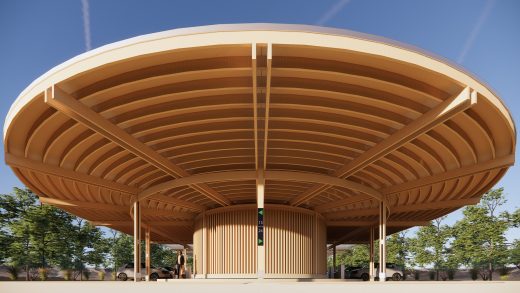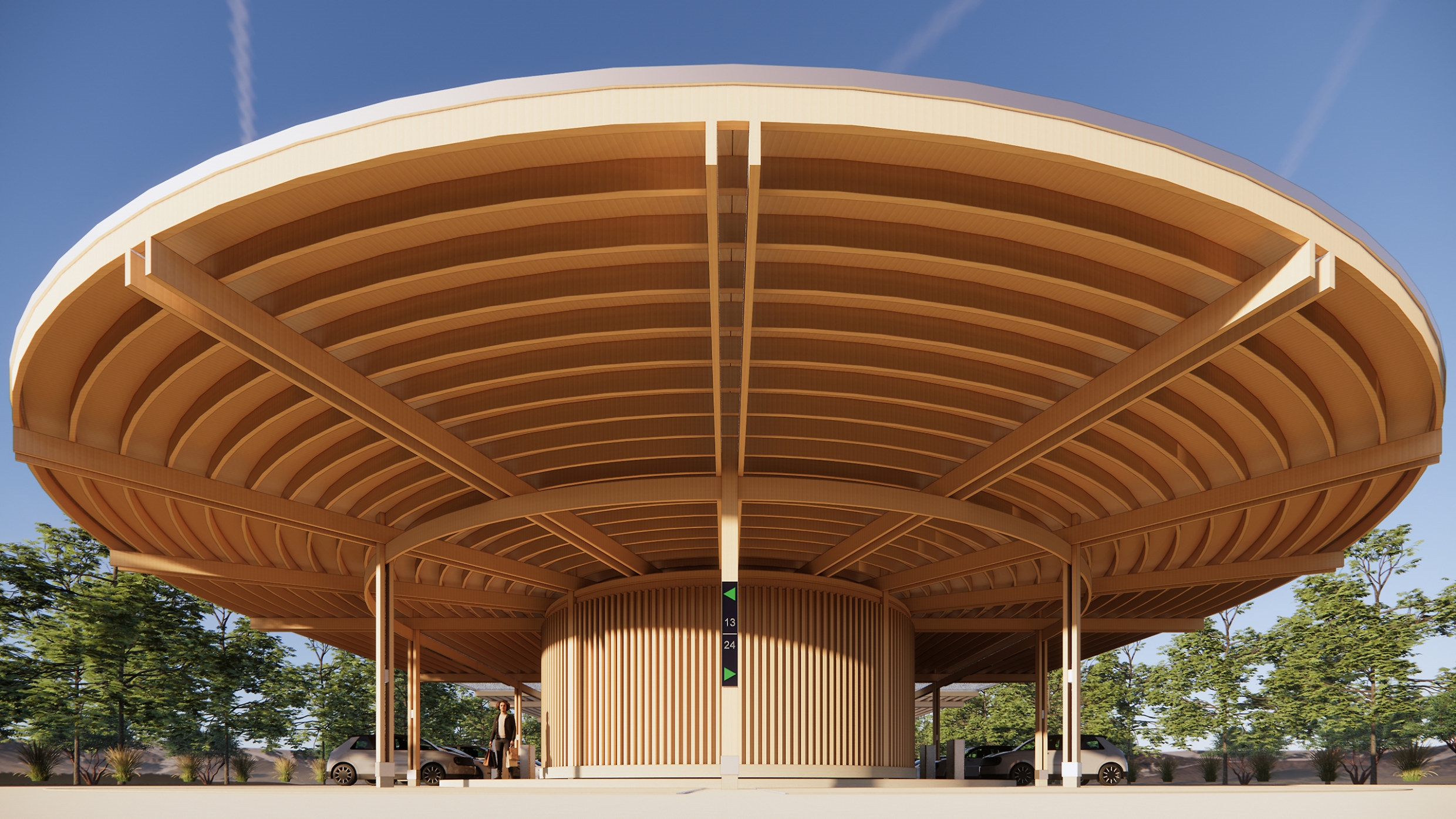Gas stations are dying. What comes next will be a radical new form of architecture
By Sam Lubell
The world’s first gas station opened in 1905 at 420 South Theresa Avenue in St. Louis. The unassuming building featured a white picket fence, behind which ran a row of large tanks that pumped petroleum directly into a vehicle’s gas tank. Since then, the gas station model hasn’t changed all that much. Asphalt. Canopies. Credit card machines. Maybe a store.
The rapid ascent of electric vehicles has presented designers and carmakers with an intriguing opportunity to rethink the service station. And while most current EV charging facilities are more infrastructure than architecture, a radically new type of service station is on the horizon that takes advantage of the time gap people spend waiting for their cars to charge.
It couldn’t come at a better time. The need for charging capabilities is becoming acute—in the U.S., the ratio of EVs to chargers is 24 to 1, according to the International Energy Agency (IEA). This has led the Biden administration to call for the opening of 500,000 charging stations by 2030, and to dedicate billions to supporting national electric vehicle infrastructure. There are opportunities for innovation, and if recent creative tweaks and a plethora of concept stations tell us anything, this already familiar model could be headed for exciting changes.
Right now, the Tesla Supercharger is by far the most ubiquitous, and reliable, type of EV charging station in the world, with over 45,000 globally. Tesla’s model doesn’t stray far from the traditional gas station model; the typical Supercharger features rows of chargers, sometimes powered by rooftop solar canopies, and offers the occasional seating area.
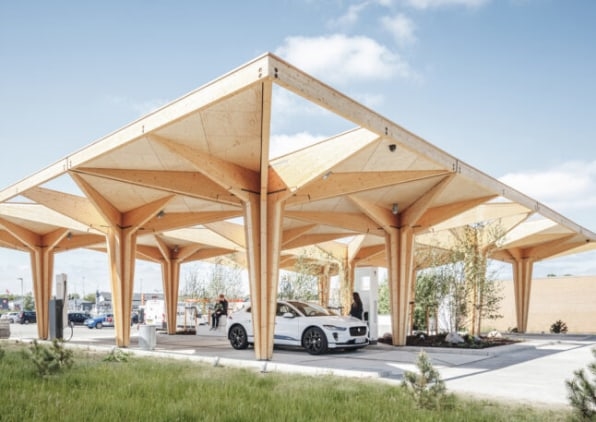
Arguably, the most stimulating new plan in operation has been designed by Danish architects Cobe, who partnered with Danish electric mobility operator Clever and European charging network E.ON Drive. They’ve rolled out a kit of modular, timber-framed, fast-charging stations whose wooden canopies form a sort of EV forest. Topped in some cases with sedum roofs and softened with greenery, they’re designed as mini oases, providing a 15-minute respite from the cement and noise of the urban world.
Cobe founder Dan Stubbergaard calls them “a welcome break and an opportunity to recharge mentally.” Their kit is designed for fast, on-site assembly and disassembly, and can expand from a single tree to an expansive cluster of them. The canopies’ green roofs are designed to retain rainfall and, via downspouts, lead water to green seepage areas. So far, 11 stations have been completed (or will be done this year), while the team is planning to create a network of 48 stations along Scandinavian highways in the coming years.
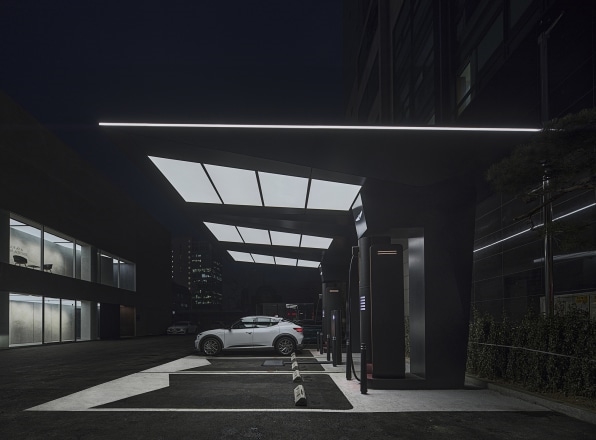
Embracing the sleekness and speed of EVs (not to mention their client’s wing-like logo) California architects Morphosis have designed a handful of charging stations for Korean carmaker Genesis in and around Seoul. The stations, also a modular kit of parts, consist of aluminum-paneled canopies edged with thin LED lights and fitted on their undersides with larger lights that act as beacons and safety features at night. The canopies’ underside lights can be swapped out for heaters or louvers to suit other environments, while additional models can accommodate wireless or indoor charging. Future iterations, says Morphosis partner Ung-Joo Scott Lee, will feature interactive features like changing colors to react to a car’s charge and data displays from users’ cars or phones.
Even more exciting than these completed plans are the flood of proposals by carmarkers, designers, architects, and enthusiasts, which run the gamut from pie in the sky to “that makes a lot of sense.” There are ideas for tulip-shaped rainwater collectors (for car washing!), ultrafast chargers, photosynthesis-inspired designs, mobile-charging robots for autonomous charging, and even car-charging towers.
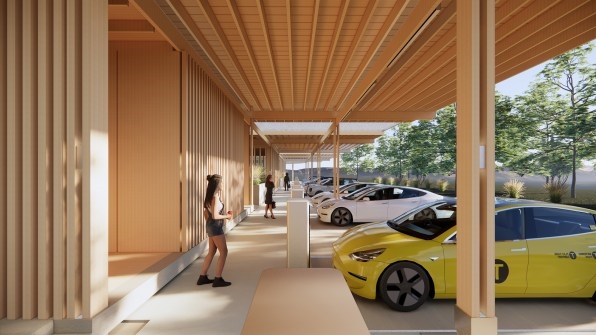
Last year Electric Autonomy Canada, an independent news platform focusing on the transition toward new mobility technologies, organized the Electric Fueling Station of the Future competition. Many entries incorporated health and wellness, offering amenities like green spaces, spas, and community areas; the opposite of the typical gas station experience. Scottish architect James Silvester won the competition with his proposal for a timber-clad, modular, photovoltaic-topped station designed like a circuit, punctuated with indoor spaces like a café, shop, and game rooms, and outdoor zones like plant-filled courtyards, children’s play areas, and exercise spaces.
Sizes could vary, and sections could be filled with just about any use. “Things change so quickly. It’s best to keep it open,” says Silvester, who notes that the one constant will be “trying to plug us back into nature.” A prototype of Silvester’s station is being planned in British Columbia by the competition’s sponsor, Canadian fuel distributor Parkland, which is clearly incorporating EV and other sustainable choices into its business model.
Nino Di Cara, president of Electric Autonomy, says many companies reached out after the competition, and he continues to field inquiries. “It’s had a tremendous impact,” he says. Di Cara calls progress in the field “incremental,” noting that while the first generation of stations’ first priority had been access to power, new iterations are now making improvements like faster chargers and other technical advances, like pull-through charging (easier for the handicapped and for large vehicles), on-site energy sources, and even wireless EV charging. He predicts that in denser areas, most retailers will soon offer charging infrastructure to help promote charging while shopping. But on highways, companies will begin offering drivers on long trips options to refresh, adding to general road safety. “It’s the idea that it’s a place you’re going to want to stop. Spending time on a break is not a bad thing.”
Tesla, which has so far relied on adjacent retailers to provide amenities, seems to be dipping its toe into providing more options, at least in a few choice spots. Last year, the company filed a permit application for a “Supercharger Diner & Drive-In” at 7001 West Santa Monica Boulevard in Hollywood, on the former site of a Shakey’s Pizza restaurant. Fitted with 34 charging stations, the sleekly curved diner would include a 3,800-square-foot lower level and 5,500 square feet of outdoor seating. Movies shown on two screens would last about 30 minutes; the same amount of time it takes to charge an EV. In 2021, Tesla filed a patent application to trademark a “T” logo for several restaurant concepts, including “pop-up,” self-service,” and “take-out” restaurants.
The future is incredibly hard to predict in such a fast-moving field. Who knows, stations could be made obsolete by in-motion technologies like dynamic wireless and conductive charging, solar roadways, and solar roofs, or by battery-swapping facilities, which could reduce waiting times to basically zero. Morphosis’ Lee predicts that existing gas station chains will morph into “micro-hotel operators.” And it’s inevitable that new typologies will spring up. Still, despite any welcome changes, the bottom line will always be reliability, says Di Cara. “This is mission-critical infrastructure. You’ve got to have it. It’s got to work.”
(27)

